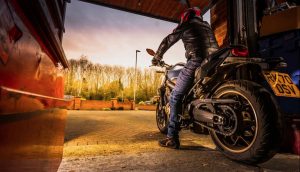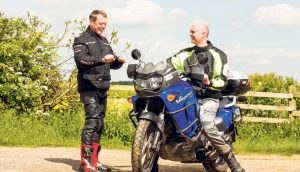
Emma Franklin, Deputy Editor at Motorcycle News, wrote this article for riders returning to the roads after Covid, there are some great tips for returning to riding after a Winter break too, so we thought we would share it with you now the weather is getting better…
In these first weeks of Spring, it’s all about easing back in gently and being aware that our skills – and those of other road users – might not be quite the same as before. Here’s how we can all get back to our biking best…
Be honest with yourself
With your bike stuck at home for months, and you using the car or public transport instead, we have to admit our skills will be a little blunted. But just the simple act of accepting that your riding’s going to be a little rusty means you’ll naturally put less pressure on yourself; your mind will be open and your body more relaxed. With this attitude, you’ll discover that you get back into the swing of things a lot quicker and easier than you would if you just assume you can pick up where you left off.
Fly solo for a bit

Do yourself a favour and ride alone for your first few rides back, just until your concentration gets back up to speed. Riding in groups is great but can be very distracting and trouble can quickly develop if everyone’s not on their A-game.
When you do get back to group rides, don’t put pressure on yourself – keep in mind the phrase ‘it doesn’t matter’. If someone is more fluid and faster, let them go. Ride your own ride.
Try this: Treat those first few solo rides back as mini lessons and give yourself some drills in the three most important things: braking, direction changing and reading bends. If you live somewhere rural, you can easily incorporate them into a ride.
Otherwise, seek out some quiet tarmac and get re-acquainted with stopping quickly and confidently, making the bike turn exactly when you want it to, and heading into corners without getting it wrong. Riding is a skill, it takes work.
Do some body work
You need to be prepared for being a bit ‘unfit’. But this isn’t about taking up jogging, it’s about getting your body used to riding again. Rather than expecting to manage 250-mile days first time out, try to build up your physical tolerance in smaller chunks. Big miles straight away may result in neck-ache, persistent numb bum, aching arms and shoulders and – if you’re an enthusiastic sportsbike or trail rider – aching legs the following day, too.
Try this: Shorter rides will rapidly get your body used to bike time. Forty-mile rides every couple of days will pay huge dividends in reawakening muscles that rarely get used for any other pursuit. Hydrate well, but don’t eat a lot before you ride – it’ll make you drowsy.
Loosen up and let go
Work hard on staying loose. Ignore the fact that it’s called a ‘handlebar grip’. Resist the urge to cling on tight, clamp on with your knees or lock your arms straight – you’ll affect how the bike responds and feels, and you’ll tire quickly too. Use a light touch and remember to breathe. After a few bedding-in miles, use more generous throttle, feel the power of your brakes, and apply obvious counter-steering – explore your bike and rediscover how it reacts and behaves to your inputs.
Try this: The ‘chicken wings’ technique is an old favourite whenever you’re at risk of riding a little tense. Check-in with yourself regularly to see if you can flap your elbows as you’re riding along. If you can, it’s a good indication that your arms are relaxed enough; if you can’t, it’s time to relax your grip a little, unlock your arms and drop your shoulders.
Use a more open hand to apply steering pressure and also to roll on and off the throttle. Put your weight down through your bum and legs and into the footrests rather than through your arms and into the handlebars.
Train your brain
The phrase ‘the older we get, the better we were’ rings true when it comes to mental sharpness. Yes, you might have been on top of your game months ago – but you won’t be now, regardless of your ability level.
Your observation and hazard perception skills will be weaker. It takes concentration to ride well, so practice by narrating the ride to yourself. After five rides doing it out loud, do it in your head for another five, then you’ll be back to your old subconscious road ninja status – or maybe better.
Try this: Sounds utterly daft, but talk yourself through what you’re seeing and doing: ‘Mirror check, lorry turning right, overtake coming up, pedestrian on the left, school ahead, yellow car waiting at the T-junction, blind bend approaching, brake, change down a gear, petrol station ahead so might be diesel spills, check mirrors, accelerate…’ You’ll feel self-conscious doing it (and it’s really tiring), but it massively focusses you.
Get professional help

Whether you feel like you need it or not, spending a day with an advanced instructor will do your riding a world of good. After a long time off the bike, it’s easy to make little mistakes which over time can compound and become habits. So nip them in the bud before they become a problem by booking a riding assessment.
If you’ve been riding donkey’s years, doing a session with a professional instructor can be tough on the ego, but put it this way: even if your riding is inch perfect, just having an expert confirm it will boost your confidence no end. And you might learn something that’ll save your life.
Try this: IAM Roadsmart offers an assessed ride for £49, where you’ll be taken out by a local assessor who’ll then feedback areas where you could improve as a rider. Then, when things open fully and the sun is truly out, you’ll be in the right place for making the most of it.
Be more defensive

As the majority of bikes have been off the road during the Winter months, drivers will struggle even more to pick us out on the busy roads.
For the first few weeks of the bike season, be doubly vigilant at junctions. Three out of every four crashes where drivers claim to have not seen a motorcycle rider happen at intersections, so ride in a position to see and be seen.
Try this: Approaching junctions, lock eyes with the driver – look to see what they are looking at. You will quite often be able to tell if they have seen you. If you are in any doubt, assess your contingency options in case they do pull out into your path. Can you stop in time? Do you have an escape route? Also, fluro riding kit will be more beneficial than ever.
Go somewhere new

As the old saying goes, familiarity breeds contempt so it’ll be all too easy to try to pick up where you left off and slip into autopilot at a time when you really need to be concentrating on your riding more than ever.
So, why not use it as motivation to break your own habits, too – and discover new roads and destinations?
Try this: Make a list of places you’ve never been or haven’t ridden to for a long time, then work out how and when you’re going to get there.
Instead of hitting your regular riding route, research locations within a 50-mile radius of home that sound intriguing and make them the focus of a series of evening rideouts. Then identify others further afield for a more substantial weekend ride. Research routes. Set destinations. Ride to them.
Pothole watch
Your favourite road may have changed since the last time you rode it, so don’t just assume everything will be the same. The road surface may have deteriorated, a roundabout may have been added or removed or the speed limits may have changed. Worse still, there might now be speed cameras on your favourite roads.
To read the original article visit https://www.motorcyclenews.com/advice/riding-tips/returning-rider/
© 2024 Eazi-Grip All Rights Reserved
Website Designed & Built by Stone Create